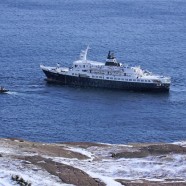For scrap and adrift, this is Canada’s motto
Lyubov Orlova, Press release # 1
Canada often sends its used commercial vessels to be broken up a long way away, in particular in Turkey.
In September 2011, the Canadian Miner, bound for Aliaga (Turkey) under tow, broke her towline, drifted and ran aground on Scatarie Island, in Nova Scotia. The cost of cutting and dismantling was evaluated at 24 million $. The wreck is dislocating and is a threat to the environment and the local fisheries. The Canadian Miner is still stranded on the island. The removal operations have been cancelled.
Lyubov Orlova, the ghost ship
Lyubov Orlova. IMO 7391434. Passenger ship. Length 100 m, 2,695 t. Cook Islands flag since 2009. Classification society Russian Maritime Register of Shipping. Built in 1976 in Kraljevica (Croatia) by Titovo. Detained in 2002 in Saint Petersburg (Russia). Former Soviet passenger ship owned by Far Eastern Shipping Company (Fesco) from Vladivostok ; acquired in 1986 by the Lubov Orlova Shipping Company, Malta based with Russian capital. This vessel with a capacity of 122 passengers was finally chartered by Cruise North Expeditions, an Inuit company which assigned her on their summer cruises in the Northern Canada. (Hudson and Baffin Bay …). As a result of salaries not paid to her 51 crew members and debts to her bunker suppliers she was seized on September 25th, 2010 in St John (Newfoundland, Canada). She was replaced by her sister-ship the Bahamian Clipper Adventurer (ex-Anna Tarasova) managed by International Shipping Partners, Miami. On August 27th, 2010, the Clipper Adventurer ran aground on a reef in the region of Nunavut, threatening the Canadian Arctic Ocean (Cf. “A new contaminated site in the Arctic”). The Lyubov Orlova was sold as is for an unknown destination of demolition. US $ 275 per ton.










